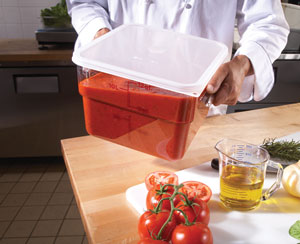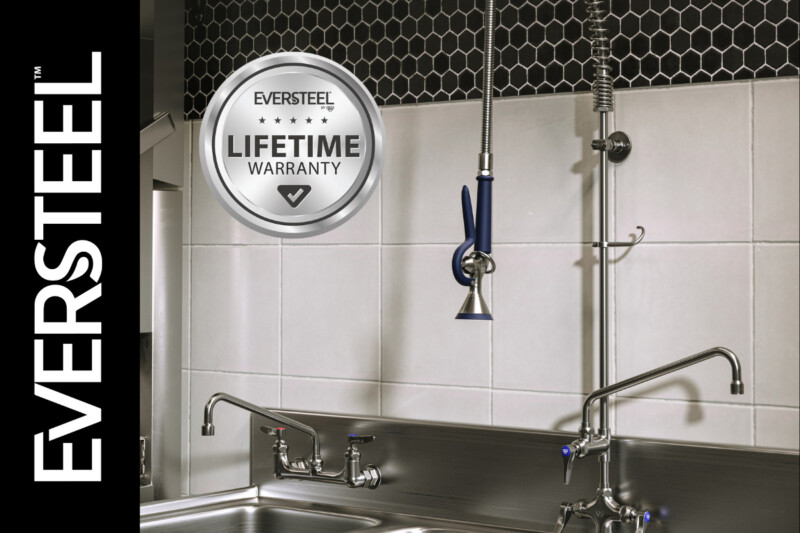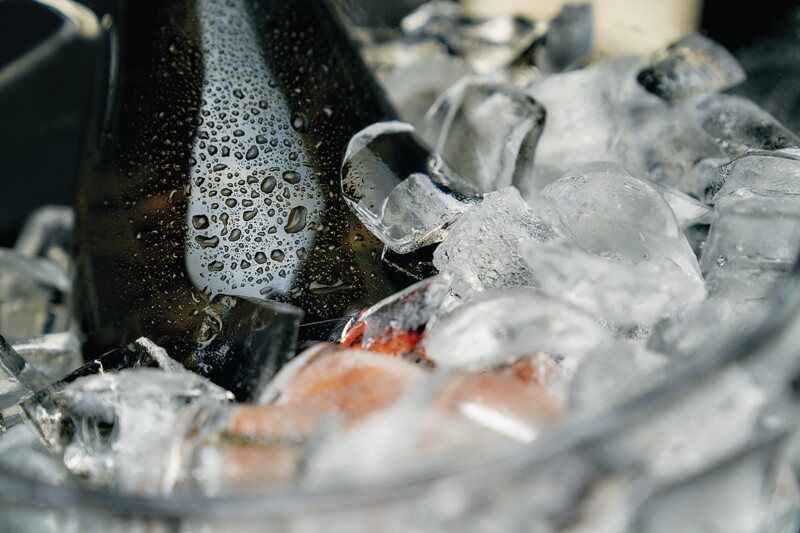
“A place for everything, everything in its place” is more than an old saw for foodservice operators. Instead, it’s a critical rule for efficient, safe and organized commercial kitchens. While you cope with food prices, customer counts, real estate costs, safety issues and other concerns, ingredient storage should not be a daily pressure point. The choices available in today’s storage containers offer you the variety, utility and safety you need to stay focused on bigger issues.
As a starting point, most storage containers are made from one of three commonly used materials: polyethylene, polypropylene and polycarbonate.
Opaque polyethylene containers are perhaps the most affordable, offering basic ingredient storage in temperatures ranging from -40°F-160°F.
Another economical choice, polypropylene containers also withstand a temperature range of -40°F-160°F. Polypropylene containers are translucent, providing some at-a-glance visibility of the food inside.
More expensive, polycarbonate containers are long-lasting, offer a clear view of what’s inside, withstand a wider range of temperatures (-40°F-210°F) and store highly acidic ingredients such as tomato-based sauces, vinaigrettes and others without staining. Flavor transfer is minimal; rice stored in a polycarbonate container will not take on the flavor of the sauce you previously stored the last time you used it. These containers easily resist cracking, bending and denting.
Does your operation have a bar? Polycarbonate’s chemical resistance makes these containers ideal for your bartenders as well, providing suitable storage for acidic fruits and other cocktail ingredients behind the bar.
At least one manufacturer offers a plastic storage pan line that withstands temperatures from -40°F-375°F. Obviously, there’s a price premium on these containers, but given that you can use them to store foods in coolers and freezers, bake them in the oven and fit them into a well for hot holding, you’re looking at a single pan that can take the place of several.
Most containers are either round or square, and each shape has its own benefits. Square containers provide better use of available space (33% better, according to one maker); liquids also pour more easily and safely from a square container’s corner. It’s easier to mix ingredients in a round container, and when the pans are stored in the cooler or are used in cold wells, the round shape allows more air circulation around the container. A general rule of thumb is round containers for refrigerated foods and liquids and square containers for dry ingredients, but they’re completely interchangeable depending on preference. Most containers of either shape are stackable, letting you maximize available storage space.
Measurements Make Sense
Some container lines come with graduated measurements. With imprinted graduations, you can see at a glance how much of each food you use for a recipe, in a meal period or in a day and track inventory effectively and accurately. As a result, you get a better understanding of your food usage and that in turn impacts ingredient reorders. Measurement markings also help your staff portion ingredients accurately, helping to control your food costs and reduce waste. Graduations can be etched into the plastics or applied. They do stay on, but if your operation uses really harsh, abrasive warewashing practices or non-approved chemicals, the markings won’t last as long as they should.
Color-Coded Convenience
Chances are your kitchen faces the same challenges of many other facilities: rushed staff, constantly changing menu and more than one spoken language. Storage containers in a variety of colors help cut through the confusion, with certain colors consistently meaning certain things specific to your operation.
For instance, consistent use of colored lids and containers ease safety concerns and make HACCP compliance easier. Always storing raw meat in containers with red lids, chicken in containers with yellow lids, produce with green lids and so forth means you and your staff know exactly what is in each container, reducing cross-contamination risks.
Another effective use of color lets your staff know exactly which containers are used for today’s menu; Mondays’ containers are blue, Tuesdays’ are yellow, Wednesdays’ are green, etc. Your staff need only use containers of a single color on any given day, increasing efficiency and reducing confusion.
Colored containers and lids also aid kitchens preparing ingredients for food trucks; containers of one color go to food truck number one, another color to food truck number two, and so on. Dedicated colors also aid kosher kitchens in keeping meat and dairy separate. Recently, some manufacturers have introduced purple to the available color palette, often suggesting it be used in allergen control. For example, gluten-free flour in a purple rolling bin won’t be confused with regular flour.
Some manufacturers offer full lines of color-coded products, including cutting boards and other accessories, so that your color coding makes the entire production process easier and more foolproof.
Many manufacturers offer standard-size lids that fit containers made by other companies. While you should always inspect your containers for wear and tear, an undamaged container with a bad lid does not mean you must order replacements for both. Look for lids in the same colors as your containers to ensure no interruption to your color-code systems. One other lid note: some lids are available with an inner and outer seal around the perimeter creating a really tight seal. They’re ideal for containers with liquid contents, especially if they’re to be transported.
What Exactly Is In Here?
When it comes to labeling your containers to reflect the contents, manufacturers offer several options to meet your preferences. Disintegrating labels give you the ability to label the contents until the container is emptied; one trip through the dishmachine dissolves the label, allowing you to use the container to hold another type of food.
If you prefer labeling your containers with a marker or grease pencil, look for containers with a dedicated space for marking. One caveat to using a permanent marker: while you may know what an older container is used for today, a label that says “Chicken, January 10, 2005” may present a flag to health inspectors. Opt for a nonpermanent writing tool, like a grease pencil.
Boxes And Bins
Food boxes and pans hold greater amounts of food than storage containers and come in opaque and clear varieties. The larger sizes of boxes accommodate bulk produce and other items. It’s always recommended that you unpack produce from its cardboard boxes. First, you avoid storing dirty, possibly pest-ridden shipping boxes in your walk-in, which is also holding foods ready to serve. Second, you avoid that “mystery box situation,” the one where a box of something got shoved to an inaccessible spot on a high shelf. You find out in two months that it’s broccoli, it’s rotted and you’ve since ordered fresh multiple times. Clear food boxes especially help you avoid this waste.
While standard storage box lids are available, lids with sliding and flip openings help prevent cross contamination; both open easily to give you easy access while covering the balance of the stored contents.
Because of the size of these containers and the fact that they’re built to hold hot food, look for pans and boxes with handles or grips; these features help prevent your staff from accidentally letting a container slip and spill, thwarting waste and potential injuries.
For bulk dry ingredients such as sugar, rice, grains and flour, stackable shelf storage bins provide your staff with easy access to stored contents. Lids with clear windows make it easy to identify contents, eliminating confusion and increasing efficiency.
Rolling bins—large-capacity bins on casters or bins placed together on a rolling shelving rack—are ideal for larger amounts of dry ingredients. The ability to roll not only makes it easy to transport ingredients to the needed station in the kitchen, it makes it easy to store the bins under a counter or shelving unit when no longer needed. Color-coded rolling bins minimize menu ingredient confusion.
Specifying Tips
Given that every kitchen serves unique needs, there are no cookie-cutter rules for specifying storage containers. Large commissaries will need many more containers than a local farm-to-table restaurant using fresh ingredients daily with limited cold storage. Chain restaurants can rely on what works—and doesn’t work—at existing units. One container manufacturer suggests you tap into your foodservice operator network and leverage your peers’ experience, what are they using?
One chef recommends figuring out what you think you’ll need, then multiplying that number by three. The result? You likely still won’t have enough. But the options available to you make making up the difference simple and specific.
RELATED CONTENT
- Advertisement -
- Advertisement -
- Advertisement -
TRENDING NOW
- Advertisement -
- Advertisement -
- Advertisement -


